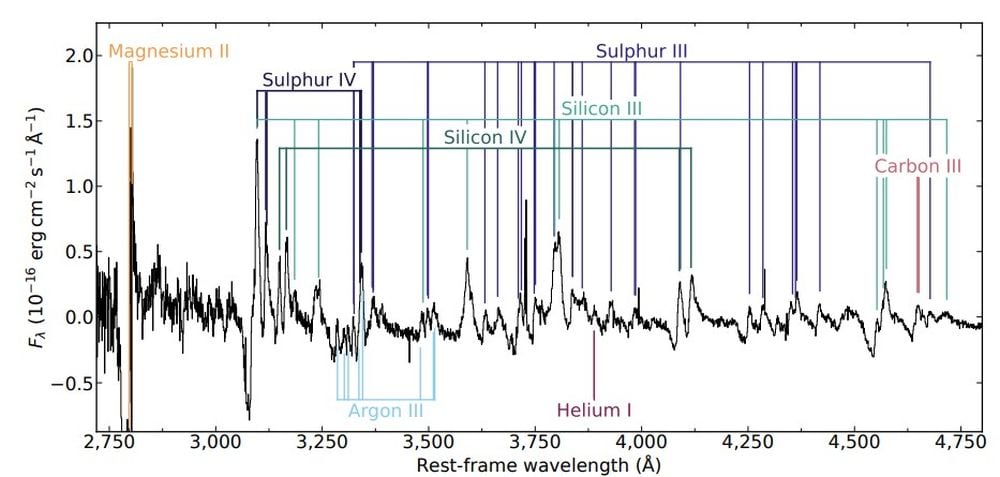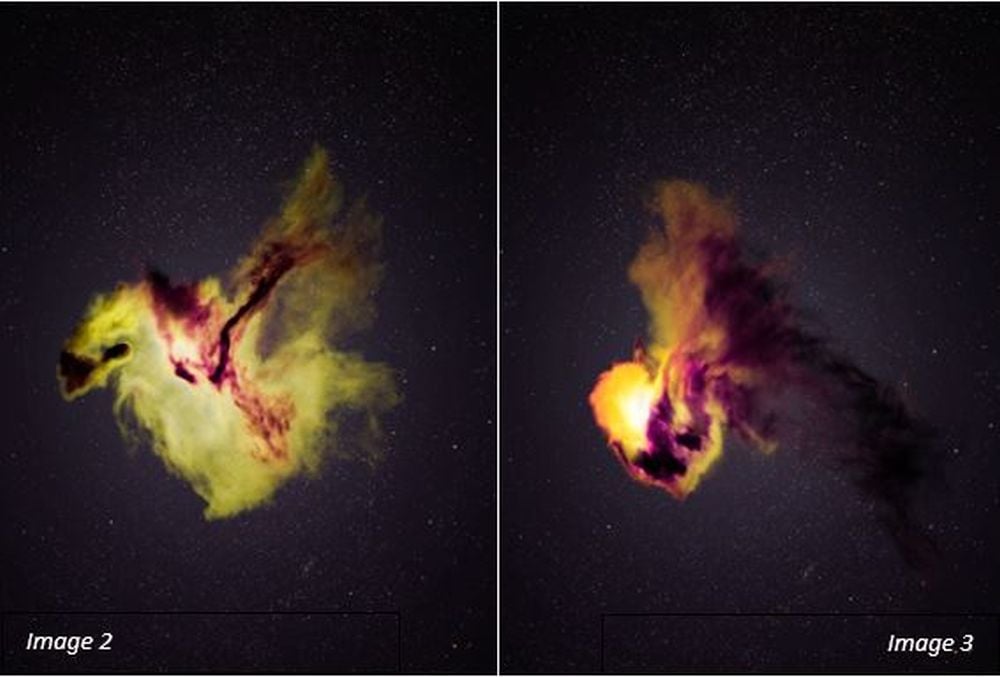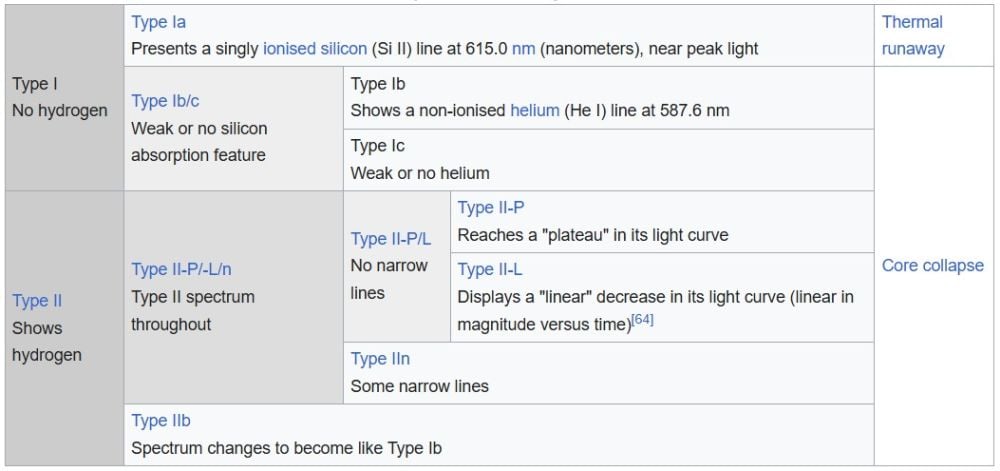Stars have layers like onions, according to theory. The layers are made of different elements, progressing from light to heavy the deeper the layers are. While the theory is strong, observing the inner layers of a star has been basically impossible.
Until now.
Astronomers working with the Keck Observatory in Hawaii have obtained spectroscopic data from a supernova discovered by the Zwicky Transient Facility in 2021. The exploding star is 2.2 billion light years away, and is named SN 2021yf. The Keck data showed the presence of ionized silicon, sulphur, and argon. These have never been observed in a supernova before, because they're usually buried under other layers.
This discovery both confirms some theoretical understanding of exploding stars and challenges others.
Astronomers know that as a massive star ages and evolves towards exploding as a supernova, it ejects material from its outer layers. They've observed it happening, and these observations show it happening. But this star has ejected more material than any previously observed star.
The observations are presented in a new paper titled "A cosmic formation site of silicon and sulphur revealed by a new type of supernova explosion." The lead author is Steve Schulze, a research associate at Northwestern University’s Center for Interdisciplinary Exploration and Research in Astrophysics (CIERA).
“This event quite literally looks like nothing anyone has ever seen before.” - Adam Miller, Northwestern University.
“This is the first time we have seen a star that was essentially stripped to the bone,” said lead author Schulze in a press release. “It shows us how stars are structured and proves that stars can lose a lot of material before they explode. Not only can they lose their outermost layers, but they can be completely stripped all the way down to the core and still produce a brilliant explosion that we can observe from very, very far distances.”
When astronomers observe a supernova, they typically see strong indications of light elements like hydrogen and helium. Layers of elements including carbon, oxygen, neon, and magnesium are also sometimes observed if the outermost hydrogen and helium have been shed. Deeper layers containing heavier elements like silicon, sulfur, and argon are obscured.
The long-standing theoretical understanding of stars says that massive stars are layered like onions, and these new Keck observations support that. By seeing a massive star's inner layers right before it explodes, the discovery is the first time that observations support this theory so clearly.
However, the observations also pose a challenge. Astrophysicists know that massive stars eject material before exploding as supernova. Shock waves from the expelled matter interact with the surrounding medium, heating it and creating observable light signatures. But SN 2021yf must have ejected much more material than thought possible, because it's stripped down to its core.
 This figure shows the elements detected in the spectrum from SN 2021yf with the Keck's Low Resolution Imaging Spectrometer one day after the ZTF spotted it. "The spectrum reveals narrow emission lines of highly ionized species of silicon, sulphur, and argon, which have never been seen in any SN before, as well as doubly ionized carbon, singly ionised magnesium, and neutral helium," the authors write. The observations also show that some of these elements are moving at about 3,000 km/sec in an ejected circumstellar medium. Image Credit: Schulze et al. 2025.
This figure shows the elements detected in the spectrum from SN 2021yf with the Keck's Low Resolution Imaging Spectrometer one day after the ZTF spotted it. "The spectrum reveals narrow emission lines of highly ionized species of silicon, sulphur, and argon, which have never been seen in any SN before, as well as doubly ionized carbon, singly ionised magnesium, and neutral helium," the authors write. The observations also show that some of these elements are moving at about 3,000 km/sec in an ejected circumstellar medium. Image Credit: Schulze et al. 2025.
“This event quite literally looks like nothing anyone has ever seen before,” added Adam Miller, an assistant professor of physics and astronomy at Northwestern and senior author on the study. “This star is telling us that our ideas and theories for how stars evolve are too narrow. It’s not that our textbooks are incorrect, but they clearly do not fully capture everything produced in nature. There must be more exotic pathways for a massive star to end its life that we hadn’t considered.”
Massive stars have the power to fuse lighter elements into heavier elements in a process called nucleosynthesis. (Without stellar nucleosynthesis, the only elements in the Universe would be those created during the Big Bang.) Throughout its life of fusion, a massive star burns lighter elements like hydrogen and helium in its outer shells, while in its core it burns successively heavier elements in its deeper layers. Eventually, a star ends up with an iron core. Iron can't be burned to release more energy, so once the core is dominated by iron, fusion virtually ceases. Without the outward pressure from fusion, the star collapses in on itself and explodes as a supernova.
Astrophysicists have observed layers of helium, carbon, and oxygen in exploding stars before, which are visible after the star has ejected its outer layer of hydrogen. By observing the silicon, sulphur, and argon, it means that this star has ejected not only its outer helium layer, but other layers as well. This likely happened in multiple episodes rather than all at once.
 Artist’s illustration of the supernova’s aftermath. Even after the star was stripped down to its core, it continued to experience violent mass-loss episodes, ejecting shells of material rich in silicon (grey), sulfur (yellow), and argon (purple). The catastrophic collision of these massive shells, as depicted in this illustration, generated a brilliant supernova explosion visible across 2.2 billion light-years of space. Credit: Keck Observatory/Adam Makarenko.
Artist’s illustration of the supernova’s aftermath. Even after the star was stripped down to its core, it continued to experience violent mass-loss episodes, ejecting shells of material rich in silicon (grey), sulfur (yellow), and argon (purple). The catastrophic collision of these massive shells, as depicted in this illustration, generated a brilliant supernova explosion visible across 2.2 billion light-years of space. Credit: Keck Observatory/Adam Makarenko.
“Stars experience very strong instabilities,” Schulze said. “These instabilities are so violent that they can cause the star to contract. Then, it suddenly liberates so much energy that it sheds its outermost layers. It can do this multiple times.”
Alex Filippenko is a professor of astronomy at UC Berkeley and a co-author of the paper. He happened to be working with the Keck when SN 2021yf was discovered, and quickly pivoted to capture its spectrum withe the Keck's LRIS. "It’s so exciting to discover a new class of exploding star, especially one that provides a confirmation of some of our theories of how massive stars evolve with time yet also reveals interesting new puzzles,” said Filippenko. “It was very fortunate that my team was using the Keck I telescope the night SN 2021yfj was discovered — we were able to obtain a spectrum that directly led to the realization that this was an incredibly special new type of supernova. Opportunities of this kind are rare!”
The silicon, sulfur and argon in the star weren't always present. These elements were created via nucleosynthesis in the star's interior as it approached the end of its life.
“This star lost most of the material that it produced throughout its lifetime,” Schulze said. “So, we could only see the material formed during the months right before its explosion. Something very violent must have happened to cause that."
That question is at the heart of this discovery. Is SN 2021yfj a new type of supernova defined by a powerful new process that stripped it of its outer layers? Some of the explanations the team is considering are interactions with a companion star, unusual and extremely powerful stellar winds, and a massive eruption that preceded the supernova explosion.
"Massive stars can lose a substantial amount of their birth mass through stellar winds, eruptions, and interaction with a companion star," the researchers write in their paper. The presence of helium in this star's circumstellar material is puzzling, since helium is usually ejected earlier in the SN process. "Since massive stars tend to live in binary systems, it may not be too unlikely to have a helium-star companion with a strong wind," they write. This could explain the helium.
The researchers think that the most likely explanation is that this massive star simply tore itself apart. Stellar cores of massive stars are under intense gravitational pressure that raises their core temperatures until nuclear fusion is reignited, generating a powerful explosion. The explosion blasts away the star's outer layers. The process is repetitive, and each time it happens, more material is ejected until the deeper core is visible.
Supernovae are classified according to spectroscopy, and classifications are centered on hydrogen. Type 1 show helium but no hydrogen and Type 2 show hydrogen. Then there are sub-types under each of those classifications based on other spectral lines. The sequence of labelled sub-types reflects the amount of stripping in the progenitor stars.
 This table shows supernova taxonomy. SN 2021yf could be a new type called Type Ien. The 'e' signifies the position of the silicon/sulphur layer in the star's structure, and the "n" signifies that the emission lines are narrow. Image Credit: Wikipedia.
This table shows supernova taxonomy. SN 2021yf could be a new type called Type Ien. The 'e' signifies the position of the silicon/sulphur layer in the star's structure, and the "n" signifies that the emission lines are narrow. Image Credit: Wikipedia.
"Our observations ... suggest that SN 2021yfj is indeed the first example of a Type Ien SN," the researchers write in their paper. This is a new type that lacks lines from hydrogen or helium, and is instead dominated by emission lines from highly ionized silicon, sulphur and argon.
Since there's only one example of this type, there are still many questions. As is often the case in astronomy, a larger dataset will likely lead to some answers.
“While we have a theory for how nature created this particular explosion,” Miller said, “I wouldn’t bet my life that it’s correct, because we still only have one discovered example. We still don’t fully understand how nature created this particular explosion. This star underscores the need to uncover more of these rare supernovae, so we can continue to study them.”

